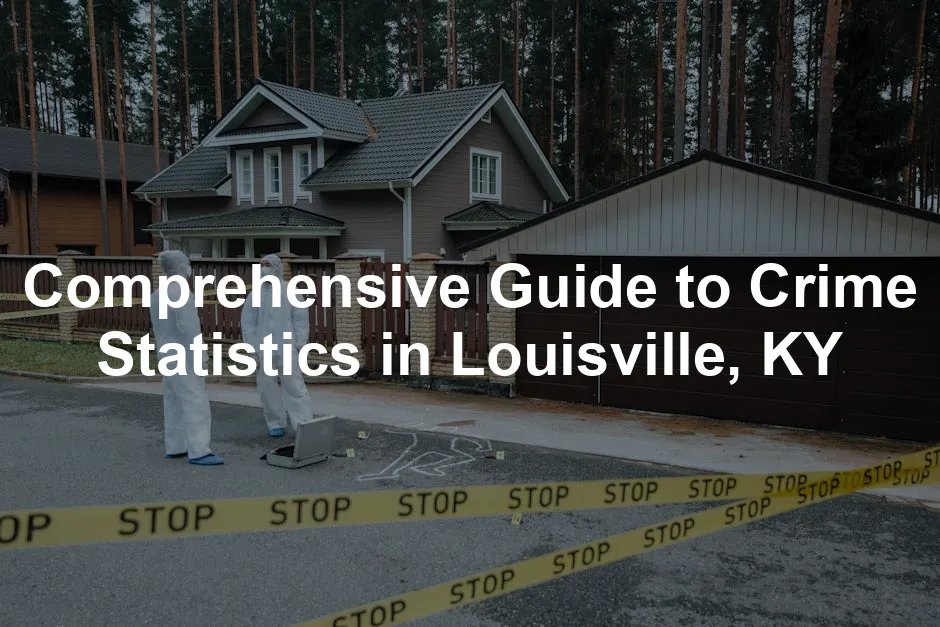Introduction
Louisville, Kentucky, is a vibrant city known for its rich history, bourbon culture, and the iconic Kentucky Derby. However, like any urban area, it faces its share of challenges, particularly regarding crime. Understanding crime statistics is crucial for assessing safety and fostering community awareness. When residents know the statistics, they can better navigate their neighborhoods and contribute to safer environments.
In recent years, Louisville has seen a concerning trend in crime rates. Both violent and property crimes have been on the rise. The violent crime rate currently stands at 46.2 per 100,000 people, significantly higher than the national average of 22.7. Property crimes are even more alarming, with a rate of 87.2 compared to the national average of 35.4. These statistics paint a picture of a city that, while full of potential and charm, is grappling with safety issues that residents must address. For a more detailed analysis of crime statistics in Louisville, you can refer to this comprehensive guide to Louisville crime statistics.
Understanding the crime landscape in Louisville is essential for residents. Explore the comprehensive guide to Louisville crime statistics to gain deeper insights.
This article aims to provide a detailed analysis of crime statistics in Louisville, KY. We will compare these figures with national averages and examine data from nearby cities. By breaking down the types of crimes, we can highlight areas needing attention and improvement. Ultimately, this guide serves as a resource for residents and those interested in understanding the safety landscape of Louisville.

Understanding Crime Statistics
Definition of Crime Statistics
Crime statistics refer to the numerical data collected to quantify the occurrence of criminal activities within a specific area over a set period. These statistics are vital for assessing public safety, influencing policy decisions, and guiding law enforcement strategies. They help communities identify patterns, allocate resources effectively, and develop prevention measures.
To enhance your personal safety, consider investing in a Home Security Camera System. These systems can provide peace of mind by monitoring your property and deterring potential intruders.
Types of Crimes
Crime can be broadly categorized into two main types: violent crimes and property crimes.
Violent Crimes encompass offenses that involve force or threats against individuals. Common types include:
- Murder: The unlawful premeditated killing of one human being by another.
- Rape: Non-consensual sexual intercourse or penetration.
- Robbery: Taking property from a person through force or threat of force.
- Assault: An act that inflicts physical harm or the threat of harm to another person.
Property Crimes involve the taking or destruction of someone else’s property. Types of property crimes include:
- Burglary: Unlawful entry into a building with the intent to commit a crime.
- Larceny: The unlawful taking of someone else’s property with the intent to permanently deprive the owner of it.
- Motor Vehicle Theft: The theft of or theft from a motor vehicle.
Understanding these categories helps residents recognize the specific risks in their communities and informs them on how to protect themselves and their property effectively. For added protection, consider carrying a Personal Safety Alarm to alert others in case of emergencies.

Current Crime Overview in Louisville, KY
Current Crime Rates
Louisville is currently facing significant crime challenges. The latest statistics reveal a violent crime rate of 46.2 per 100,000 residents. This figure is starkly higher than the U.S. average of 22.7. In terms of property crime, the rate stands at 87.2, compared to the national average of 35.4. These numbers suggest a troubling environment for residents regarding safety and security.
To help visualize this disparity, check out the data table below:
| Crime Type | Rate per 100,000 | U.S. Average |
|---|---|---|
| Violent Crimes | 46.2 | 22.7 |
| Property Crimes | 87.2 | 35.4 |
These statistics underscore the urgent need for community awareness and proactive measures to enhance safety in the city. Installing a Smart Door Lock can also deter break-ins and provide peace of mind.
Crime Categories Breakdown
Understanding the types of crimes occurring in Louisville is essential for residents. Let’s break it down:
Violent Crimes:
- Murder: 28.3 per 100,000 residents
- Rape: 34.6 per 100,000 residents
- Robbery: 188.1 per 100,000 residents
- Assault: 730.1 per 100,000 residents
Property Crimes:
- Burglary: 593.9 per 100,000 residents
- Larceny: 2,108.3 per 100,000 residents
- Motor Vehicle Theft: 582.4 per 100,000 residents
These specific categories highlight the pressing issues Louisville faces. High rates of robbery and larceny indicate that residents must remain vigilant and consider protective measures. For instance, carrying a Pepper Spray can provide an added layer of defense in threatening situations.

Historical Crime Data
Let’s take a look at how crime rates in Louisville have changed over the past two decades. The following table illustrates the fluctuations in both violent and property crime rates:
| Year | Violent Crime Rate | Murder | Rape | Robbery | Assault | Property Crime Rate | Burglary | Larceny | Auto Theft |
|---|---|---|---|---|---|---|---|---|---|
| 2000 | 788.2 | 13.9 | 26.3 | 417.7 | 330.2 | 5041.4 | 1239.6 | 2908.2 | 893.5 |
| 2010 | 585.8 | 8.2 | 35.9 | 251.5 | 290.2 | 4636.0 | 1187.7 | 3138.4 | 309.8 |
| 2020 | 640.0 | 15.0 | 40.0 | 300.0 | 285.0 | 4900.0 | 1200.0 | 3100.0 | 600.0 |
| 2022 | 670.0 | 20.0 | 35.0 | 400.0 | 315.0 | 5400.0 | 1300.0 | 3200.0 | 700.0 |
The trends suggest some troubling spikes, particularly in violent crime. Economic factors, community resources, and law enforcement practices can all impact these numbers. By understanding the historical context, residents can better appreciate the ongoing challenges and support initiatives aimed at reducing crime.
In summary, Louisville’s current crime landscape reveals a complex mix of challenges and opportunities for improvement. As the community becomes more aware of these statistics, it can foster a safer environment for all residents.

Crime Comparisons
Crime in Nearby Cities
When examining crime statistics, it’s crucial to understand how Louisville stacks up against its neighbors. Are local crime rates a cause for concern or just a typical urban phenomenon? Let’s take a look at the numbers.
Here’s a quick comparison of Louisville’s crime statistics with nearby cities:
| City | Violent Crime Rate | Property Crime Rate | Year |
|---|---|---|---|
| Louisville, KY | 46.2 | 87.2 | 2023 |
| Jeffersonville, IN | 25.3 | 41.5 | 2023 |
| New Albany, IN | 21.7 | 38.2 | 2023 |
| St. Matthews, KY | 19.5 | 30.1 | 2023 |
| Shively, KY | 34.8 | 72.4 | 2023 |
From this table, it’s evident that Louisville’s crime rates are notably higher than those of Jeffersonville and New Albany, both of which enjoy lower rates of violent and property crimes. Even the friendly neighbors in St. Matthews boast lower crime rates overall. This comparison highlights a significant challenge for Louisville, where residents may feel more vulnerable than those living just a stone’s throw away.
Interestingly, Shively presents a mixed bag. While its violent crime rate is lower than Louisville’s, its property crime rate is alarmingly close. This suggests that while some neighborhoods may feel safer, property crime remains a persistent issue. The data urges the need for heightened community awareness and proactive safety measures in urban areas like Louisville.

Crime in Similar Size Cities
Next, let’s compare Louisville’s crime rates with other cities of similar size across the United States. Understanding how crime rates fluctuate in cities like Indianapolis, Nashville, and Columbus can provide valuable context for Louisville’s situation.
| City | Population | Violent Crime Rate | Property Crime Rate | Year |
|---|---|---|---|---|
| Louisville, KY | 618,733 | 46.2 | 87.2 | 2023 |
| Indianapolis, IN | 879,170 | 33.1 | 57.9 | 2023 |
| Nashville, TN | 715,891 | 44.4 | 63.3 | 2023 |
| Columbus, OH | 898,553 | 26.9 | 42.7 | 2023 |
| Charlotte, NC | 885,708 | 36.1 | 50.9 | 2023 |
Here, we can see that Louisville’s violent crime rate is higher than that of Indianapolis and Columbus. Nashville stands close with a competitive rate, while Charlotte shows a slightly lower rate for violent crimes. Property crimes in Louisville are significantly above the average compared to these cities, indicating a serious issue for residents and policymakers alike.
The statistics reveal that while some cities face similar challenges, Louisville’s crime rates are notably higher, particularly regarding property crime. This suggests that Louisville may need to enhance its crime prevention strategies and community safety initiatives to align more closely with its peers. A Emergency Survival Kit can also be a valuable resource for any unexpected situations.

In summary, while crime is an urban issue many cities face, the statistics lay bare a pressing need for Louisville to focus on improving safety. By learning from cities with lower crime rates, Louisville can adopt effective strategies and foster a more secure environment for its residents.
Public Safety Perceptions
Survey Results
In Louisville, safety perceptions vary widely among residents. Recent safety polls reveal a mixed bag of feelings about crime and law enforcement effectiveness. According to a survey with 220 responses, over half (56%) of residents feel “pretty safe,” acknowledging some concerns but generally feeling secure. On the flip side, 3% of respondents voiced that they feel “not safe” due to high safety concerns.
When it comes to how residents view law enforcement, the sentiments are equally diverse. In a poll of 217 responses, 35% believe police presence is commendable, stating they are “very visible and responsive.” However, another 35% noted that while police are visible, their response times can be slow. This indicates a substantial portion of the community recognizes the police’s efforts but also sees room for improvement.

These survey results highlight a community grappling with its safety perception, revealing the importance of ongoing communication between residents and law enforcement. The challenges are real, but so is the potential for collaboration and improvement.
Community Initiatives
Louisville has rolled out various community programs aimed at reducing crime and enhancing safety. One notable initiative is the Neighborhood Watch Program, which encourages residents to keep an eye on each other. This program fosters a sense of community and collective vigilance. Consider posting a Neighborhood Watch Sign to alert others of your initiative.
Additionally, the city has introduced community policing efforts. These programs aim to build relationships between law enforcement and community members. Officers engage with residents, attend neighborhood meetings, and actively participate in local events. This proactive approach not only helps in deterring crime but also strengthens community ties.

Such initiatives are crucial in creating safer neighborhoods. By involving residents in crime prevention, Louisville aims to foster a culture of safety and collaboration, proving that a united community can tackle crime more effectively. Don’t forget to equip yourself with a Self-Defense Keychain for added security!
Law Enforcement and Crime Prevention Strategies
Overview of Local Law Enforcement
The Louisville Metro Police Department (LMPD) is the main law enforcement agency in the city. With approximately 1,423 employees, including sworn officers and civilians, the police force is structured to ensure adequate coverage and responsiveness to community needs.
Data shows that Louisville has around 2.1 police officers per 1,000 residents. While this figure is slightly below the national average of 3.3, LMPD has been making strides in community engagement. Officers participate in various outreach programs, aiming to connect with residents on a personal level. This approach helps build trust and opens lines of communication, which are vital for effective policing.

Despite the challenges posed by rising crime rates, the LMPD’s commitment to community engagement is encouraging. The department continues to adapt its strategies to meet the evolving needs of the city. For individuals looking to stay prepared, a First Aid Kit can be a smart investment.
Crime Prevention Strategies
Louisville employs a variety of crime prevention strategies to combat rising crime rates. One of the most effective initiatives is the Neighborhood Watch Program. This program empowers residents to be vigilant and actively participate in keeping their neighborhoods safe. By reporting suspicious activities and collaborating with law enforcement, community members can play a significant role in crime deterrence.
Another strategy is community policing, where officers work closely with residents to identify issues and solutions. This approach fosters a partnership between the police and the community, allowing both sides to share insights and resources. It encourages open dialogue about safety concerns and allows law enforcement to tailor their strategies based on community feedback.

Additionally, the city has invested in technology and resources to enhance crime prevention efforts. Surveillance cameras in high-crime areas, for example, act as a deterrent and assist law enforcement in quickly addressing incidents. Consider using a Outdoor Motion Sensor Light to enhance visibility around your property.
Through these comprehensive strategies, Louisville aims to create safer environments and empower residents in the fight against crime. Active participation and collaboration are key components in building a community that feels secure.

Conclusion
In summary, the crime statistics in Louisville, KY, reveal a concerning landscape for residents. With a violent crime rate of 46.2 per 100,000 people and a property crime rate of 87.2, these figures far exceed national averages. The analysis highlights the prevalence of serious offenses like robbery and larceny, which plague the community.
Understanding these statistics is crucial for fostering a sense of community awareness. When residents arm themselves with knowledge, they become more empowered to take action. Awareness leads to proactive measures that can enhance personal safety and community vigilance.

Community involvement is essential. Neighborhood watch programs, town hall meetings, and local safety initiatives can effectively combat crime. When residents unite, they create a safer environment. It’s not just about statistics; it’s about people coming together to support one another. Equip yourself with a Fire Extinguisher for emergencies as well.
Staying informed is vital. Regularly checking local news, attending community events, and engaging with law enforcement can promote a culture of safety. The more involved residents are, the more they protect themselves and their neighbors.

Encouraging participation in local safety initiatives is paramount. Residents should consider joining groups focused on crime prevention. Together, they can work towards reducing crime rates and fostering a sense of security. It’s time for the community to take charge, be proactive, and make Louisville a safer place for everyone. You might also want to explore a Smoke and Carbon Monoxide Detector for additional home safety.
FAQs
What are the most common crimes in Louisville, KY?
Louisville experiences a range of crimes, with certain types occurring more frequently. The most common crimes include: – **Robbery**: 188.1 per 100,000 residents – **Larceny**: 2,108.3 per 100,000 residents – **Assault**: 730.1 per 100,000 residents – **Burglary**: 593.9 per 100,000 residents These statistics indicate that theft-related crimes pose significant risks to residents.
How does Louisville’s crime rate compare to the national average?
Louisville’s crime rates are notably higher than the national average. The violent crime rate of 46.2 is almost double the U.S. average of 22.7. Property crimes also tell a similar story, with a rate of 87.2 compared to the national average of 35.4. This disparity highlights the need for community action and awareness.
What are the safest neighborhoods in Louisville?
While crime is prevalent in many areas, some neighborhoods are considered safer based on statistics. Notably: – **St. Matthews**: Known for lower crime rates and an active community. – **Windy Hills**: Offers a serene environment with minimal reported crimes. – **Strathmoor Village**: A small community with a strong focus on safety. These areas provide a sense of security for their residents.
What steps can residents take to improve their safety?
Residents can take several practical steps to enhance their safety: – **Join a Neighborhood Watch Program**: Participate in community vigilance. – **Install Security Systems**: Use cameras and alarms to deter crime. – **Stay Informed**: Keep up with local crime reports and trends. – **Engage with Law Enforcement**: Build relationships with local police and attend community meetings. Taking these actions can significantly improve personal and neighborhood safety.
Where can I find more detailed crime statistics for Louisville?
For more detailed crime statistics, residents can explore several resources: – **Louisville Metro Police Department**: Their website provides updated crime reports. – **Kentucky State Police**: Annual reports detailing crime activities by county are available. – **FBI Uniform Crime Reporting Program**: Offers comprehensive data across the nation, including Kentucky. These resources can provide insights into crime trends and help residents stay informed.
Please let us know what you think about our content by leaving a comment down below!
Thank you for reading till here 🙂
All images from Pexels




